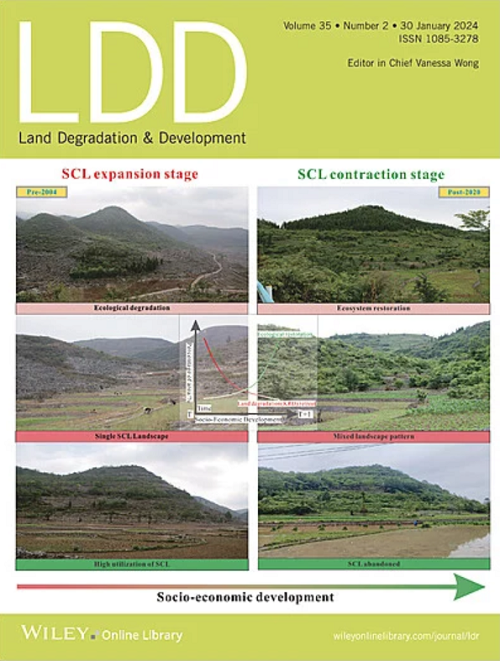利益相关者驱动的耕地整理空间定位:中国城市化、粮食安全和环境的权衡管理
IF 3.7
2区 农林科学
Q2 ENVIRONMENTAL SCIENCES
引用次数: 0
摘要
在过去的40年里,中国在耕地整理上投入了2980亿美元,在快速城市化和耕地流失的情况下,显著提高了农业生产和粮食安全。然而,缺乏整合农民、社区和决策者等当地利益相关者观点的对CLC潜力的定量、空间明确评估,阻碍了CLC倡议的有效性和效率,限制了它们为农业生产力和可持续性带来持久效益的能力。我们采用知识协同生产的方法,将空间多标准分析(MCA)与多利益相关者参与相结合,以评估江苏省CLC的潜力并确定优先领域。我们确定了CLC实施的优先领域和考虑因素,以支持向生产性、可持续农业系统的过渡,并将813个乡镇划分为7个CLC优先类型。我们的分析确定41.82%的区域最适合进行资源改善整合,33.83%的区域适合进行模式优化整合,9.84%的区域适合进行利用增强整合,14.51%的区域适合进行综合标准整合。此外,686个具有低至极低CLC潜力的乡镇被确定为优先保护和发展地区。这些空间上明确的结果为区域优先排序、目标投资和利益相关者驱动的CLC规划提供了坚实的基础。本研究的方法和结果为中国乃至更广泛的CLC中利益相关者驱动的空间规划提供了一个可复制的框架,为解决城市化、粮食安全和环境之间的关键权衡提供了实用的、空间上明确的规划。本文章由计算机程序翻译,如有差异,请以英文原文为准。
Stakeholder‐Driven Spatial Targeting for Cultivated Land Consolidation: Managing Trade‐Offs Between Urbanization, Food Security, and Environment in China
Over the past four decades, China has invested $298 billion in cultivated land consolidation (CLC), significantly boosting agricultural production, and food security despite rapid urbanization and cultivated land loss. However, the absence of a quantitative, spatially explicit evaluation of CLC potential that integrates local stakeholder perspectives from farmers, community, and decision‐makers has hindered the effectiveness and efficiency of CLC initiatives, constraining their ability to deliver enduring benefits for agricultural productivity and sustainability. We used a knowledge co‐production approach integrating spatial multi‐criteria analysis (MCA) with multi‐stakeholder engagement to evaluate CLC potential and identify priority areas in Jiangsu Province. We identified priority areas and considerations for CLC implementation to support the transition toward productive, sustainable agricultural systems, categorizing 813 townships into seven CLC priority types. Our analysis identified 41.82% of the area as being most suitable for resource improvement consolidation, 33.83% for pattern optimization consolidation, and 9.84% for utilization enhancement consolidation, with 14.51% designated for combined‐criteria consolidation. Additionally, 686 townships with low to very low CLC potential were identified as priority areas for protection and development. These spatially explicit results provide a robust foundation for regional prioritization, targeted investment, and stakeholder‐driven CLC planning. The methodology and findings of this study offer a replicable framework for stakeholder‐driven spatial planning in CLC both in China and more broadly, providing practical, spatially explicit plans for addressing critical trade‐offs between urbanization, food security, and the environment.
求助全文
通过发布文献求助,成功后即可免费获取论文全文。
去求助
来源期刊

Land Degradation & Development
农林科学-环境科学
CiteScore
7.70
自引率
8.50%
发文量
379
审稿时长
5.5 months
期刊介绍:
Land Degradation & Development is an international journal which seeks to promote rational study of the recognition, monitoring, control and rehabilitation of degradation in terrestrial environments. The journal focuses on:
- what land degradation is;
- what causes land degradation;
- the impacts of land degradation
- the scale of land degradation;
- the history, current status or future trends of land degradation;
- avoidance, mitigation and control of land degradation;
- remedial actions to rehabilitate or restore degraded land;
- sustainable land management.
 求助内容:
求助内容: 应助结果提醒方式:
应助结果提醒方式:


